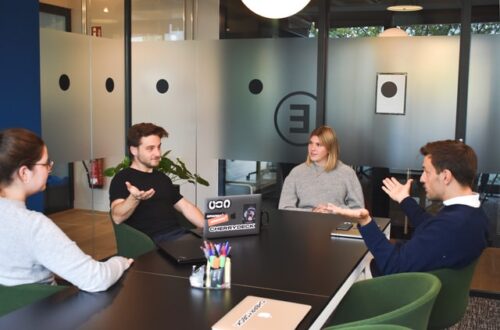In today’s fast-paced and ever-evolving world, solving complex challenges requires a diverse range of perspectives and ideas. One key factor that often goes unnoticed is the impact of thinking preferences on problem-solving. Thinking preferences refer to the various ways individuals process information, make decisions, and approach tasks. By understanding and embracing these different thinking styles, teams can unlock their full potential and overcome even the most daunting challenges.
Each person has a unique thinking preference, which can be categorized into four main styles: analytical, practical, creative, and relational. Analytical thinkers are logical and detail-oriented, focusing on facts and data. Practical thinkers are action-oriented and prefer hands-on approaches. Creative thinkers thrive on innovative and unconventional ideas, while relational thinkers emphasize collaboration and building relationships. By recognizing and valuing these diverse thinking styles, teams can leverage the strengths of each individual and foster a more inclusive problem-solving environment.
The impact of thinking preferences on problem-solving
Thinking preferences play a crucial role in the problem-solving process. When faced with a complex challenge, individuals with different thinking styles bring their unique perspectives, skills, and approaches to the table. For example, analytical thinkers excel at breaking down problems into smaller components, identifying patterns, and conducting thorough research. Practical thinkers, on the other hand, are skilled at implementing practical solutions and taking action. Creative thinkers can generate innovative ideas and think outside the box, while relational thinkers excel at building consensus and nurturing relationships.
By harnessing the power of these diverse thinking preferences, teams can approach complex challenges from multiple angles, leading to more effective and comprehensive solutions. It is important to recognize that no thinking preference is superior to another; they are simply different ways of processing information. Embracing this diversity not only enhances problem-solving outcomes but also promotes a culture of inclusivity and respect within the team.
Leveraging thinking preferences for complex challenges
When tackling complex challenges, it is crucial to leverage the different thinking preferences within a team. By doing so, teams can tap into a wider range of perspectives and expertise, leading to more robust problem-solving processes. One effective way to leverage thinking preferences is through a collaborative problem-solving approach. This involves bringing together individuals with different thinking styles and encouraging them to contribute their unique insights and ideas.
For example, when developing a new product, a team with diverse thinking preferences can ensure that all aspects of the product, from its functionality to its design, are thoroughly considered. Analytical thinkers can focus on conducting market research and analyzing data, while creative thinkers can brainstorm innovative features. Practical thinkers can provide input on the feasibility of different ideas, and relational thinkers can ensure that the product meets the needs and preferences of the target audience. By combining these different thinking preferences, teams can create well-rounded solutions that address all aspects of the complex challenge.
Case studies showcasing the power of inclusion
Numerous case studies demonstrate the power of leveraging thinking preferences to solve complex challenges. One such example is the Apollo 13 mission. When an oxygen tank exploded onboard the spacecraft, the crew faced a life-threatening situation. By bringing together individuals with different thinking preferences, NASA was able to devise a creative and practical solution to bring the astronauts safely back to Earth. Analytical thinkers meticulously analyzed the available resources and possible solutions, while practical thinkers devised innovative ways to conserve power and oxygen. Creative thinkers came up with unconventional ideas, such as using duct tape and socks to create a makeshift CO2 filter. Relational thinkers ensured effective communication and collaboration among the team members. This collaborative problem-solving approach, leveraging diverse thinking preferences, ultimately saved the lives of the astronauts.
Strategies for fostering inclusivity in problem-solving
Creating an inclusive problem-solving environment requires intentional strategies and practices. One effective strategy is to establish clear goals and objectives for the team. By providing a shared purpose, individuals with different thinking preferences can align their efforts towards a common goal. Additionally, it is important to create a safe and respectful space where all ideas are valued and encouraged. This can be achieved through active listening, open-mindedness, and constructive feedback.
Another strategy is to promote diversity within the team. By recruiting individuals with diverse backgrounds, experiences, and thinking preferences, teams can benefit from a broader range of perspectives and ideas. It is also essential to provide training and development opportunities that enhance individuals’ understanding of thinking preferences and their ability to collaborate effectively. This can include workshops, seminars, and team-building exercises aimed at fostering inclusivity and understanding.
Tools and resources for identifying and understanding thinking preferences
Several tools and resources are available to help identify and understand thinking preferences within a team. One widely used tool is the Myers-Briggs Type Indicator (MBTI), which assesses individuals’ personality types based on their preferences in four key areas: extraversion vs. introversion, sensing vs. intuition, thinking vs. feeling, and judging vs. perceiving. The MBTI can provide valuable insights into individuals’ thinking preferences and help teams understand how to leverage these preferences effectively.
Another resource is the Herrmann Brain Dominance Instrument (HBDI), which assesses individuals’ thinking preferences based on four quadrants: analytical, practical, creative, and relational. The HBDI provides a visual representation of individuals’ thinking preferences, helping teams understand and appreciate the diversity of thought within their group.
Overcoming challenges and biases in inclusive problem-solving
While leveraging thinking preferences can lead to more effective problem-solving, there are challenges and biases that need to be overcome. One common challenge is the tendency to favor one thinking preference over others. This can result in a lack of diversity in ideas and perspectives. To overcome this challenge, it is important to create a culture that values and embraces all thinking preferences equally. This can be achieved through regular communication, feedback, and recognition of individuals’ contributions.
Biases can also hinder inclusive problem-solving. Stereotypes and preconceived notions about certain thinking preferences can lead to the dismissal of valuable ideas or the exclusion of individuals with different thinking styles. Overcoming biases requires self-awareness and a commitment to challenging and changing these biases. By actively seeking out diverse perspectives and valuing all thinking preferences, teams can overcome biases and foster a more inclusive problem-solving environment.
The role of leadership in promoting inclusive thinking
Leadership plays a crucial role in promoting inclusive thinking within a team. Leaders can set the tone by modeling inclusive behaviors and creating a safe and respectful environment for all team members. They can actively seek out diverse perspectives, encourage collaboration, and ensure that all voices are heard and valued. Leaders can also provide training and development opportunities that enhance individuals’ understanding of thinking preferences and promote inclusive problem-solving practices.
Additionally, leaders can establish clear expectations for inclusive thinking and hold team members accountable for their contributions to the problem-solving process. By emphasizing the importance of leveraging thinking preferences and fostering inclusivity, leaders can create a culture that values diversity of thought and encourages innovative solutions to complex challenges.
The benefits of leveraging thinking preferences in the workplace
Leveraging thinking preferences in the workplace offers numerous benefits. Firstly, it leads to more comprehensive and innovative problem-solving outcomes. By tapping into the diverse perspectives and expertise of individuals with different thinking preferences, teams can develop solutions that consider multiple angles and factors. This can result in more effective strategies, products, and services.
Secondly, leveraging thinking preferences fosters a culture of inclusivity and diversity in the workplace. When individuals feel valued and respected for their unique perspectives and approaches, they are more likely to be engaged and motivated. This can lead to increased productivity, creativity, and employee satisfaction.
Lastly, leveraging thinking preferences enhances team dynamics and collaboration. By recognizing and valuing the strengths of each thinking preference, teams can foster effective communication, collaboration, and decision-making processes. This creates a positive work environment where individuals feel empowered to contribute their ideas and perspectives.
Conclusion: Harnessing the power of inclusion for complex challenges
In conclusion, understanding and leveraging thinking preferences is a powerful tool for solving complex challenges. By embracing the diverse ways individuals process information and approach tasks, teams can tap into a wealth of perspectives, ideas, and expertise. This inclusive problem-solving approach leads to more comprehensive and innovative solutions.
To foster inclusivity in problem-solving, organizations should implement strategies that promote diversity, provide training and development opportunities, and create a safe and respectful space for collaboration. Tools and resources, such as the MBTI and HBDI, can aid in identifying and understanding thinking preferences within a team.
Leadership also plays a crucial role in promoting inclusive thinking. By modeling inclusive behaviors, setting clear expectations, and providing support and guidance, leaders can create a culture that values diversity of thought and encourages innovative problem-solving.
Overall, harnessing the power of inclusion through leveraging thinking preferences is not only beneficial for solving complex challenges but also for creating a work environment that values diversity, fosters collaboration, and drives success.
To learn more about harnessing the power of inclusion and leveraging thinking preferences in problem-solving, explore our comprehensive HBDI training programs and resources. Join us in creating a more inclusive and innovative workplace.












